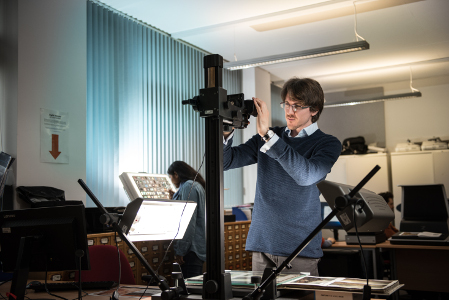March 8, 2022, by Matt Davies
DTH Resources Spotlight: 2D and 3D digital capture by Chloe Love
If you are a student or member of staff in the Faculty of Arts, DTH resources are available exclusively to you and may aid you with your work and research. This is the first in a series of posts on our resources and equipment. Today DTH Marketing volunteer Chloe Love takes a look at the many different options for 2D and 3D digital capture that are available in – and beyond – the DTH.
Why should you use our resources?
We have professional equipment and software that can guarantee you high-quality results. All our PCs are networked so you can save any work you do in DTH via your Office 365 account, allowing access, storage and security for your work.
We also have a loan system so you can borrow digital capture equipment to take off-site; that includes still and video cameras, as well as audio recording devices and now even 3D and 360 degree cameras! Our staff and volunteers are in DTH 10-5 to offer advice and support but we do recommend that you email us first if you wish to borrow equipment, just to ensure that we have it in stock.
What is 2D capture?
There are many things that you can do using the 2D capture technology that we have in DTH including A4, A3 A0 (that’s poster / map size!) scanners. You could even convert any 35mm slides, negatives or photographs you have into digital versions.
You can scan excerpts from a journal or book and digitally turn them into text that can then be edited using OCR software. You can scan printed images and then adjust their quality or crop them. You could, for example, create usable versions of damaged or fading books or documents. If it’s an awkward shape or size, or needs specialist lighting, you could use the copystand with light units and DSLR camera. This is operated from a PC – and by the way, all of our PCs now have the Adobe Creative Cloud package, including Photoshop and Lightroom for instant editing.*
Students and staff in the Faculty of Arts are often required to complete a great deal of reading, you could scan passages from books and turn them into pdfs using the book scanner – although copyright restrictions do have to be followed. You will find plenty of info on what you can and cannot do on display in DTH.
What is 3D capture?
Most students and staff in the Faculty of Arts will have never used 3D scanning technology before. If you want to give your research the ‘wow factor’ and are prepared to put some learning time in, then staff and volunteers in the DTH may be able to help you!
Photogrammetry is a process where many overlapping photographs of an object, are captured and then put through specialist software to produce a digital 3D model. You can find out more about the process here. DTH now has photogrammetry facilities, including camera, tripod, light tent, turntable, and Agisoft Metashape software. It can be a timely process, but if you are interested in using the equipment and are willing to learn, please email us.
We also have Structure Sensors, which are 3D cameras that attach to an iPad (also available) These are a lot easier and faster to use than the photogrammetry process, and can be used to capture objects and spaces, although the resulting objects are not as detailed or high resolution.
DTH 2D/3D digital capture equipment in summary.
2D ie; books, docs, journals, posters, photos, film, transparencies, slides we recommend that you use our A4/A3 flatbed scanners or bookscanner with book cradle. Get in touch if you need to use the copystand and camera or A0 scanner.
3D ie; archaeological finds, decorative objects, models, spaces, people! Get in touch if you would like to use the Photogrammetry studio, or borrow a Structure Scanner.
*Adobe’s Creative Cloud package also includes InDesign, Premier Pro, Acrobat DC, Illustrator.
You will find guides on how to use many of the DTH resources mentioned above at our SharePoint page.
Email us with any queries or to book equipment at artsdigitahub@nottingham.ac.uk
No comments yet, fill out a comment to be the first




Leave a Reply